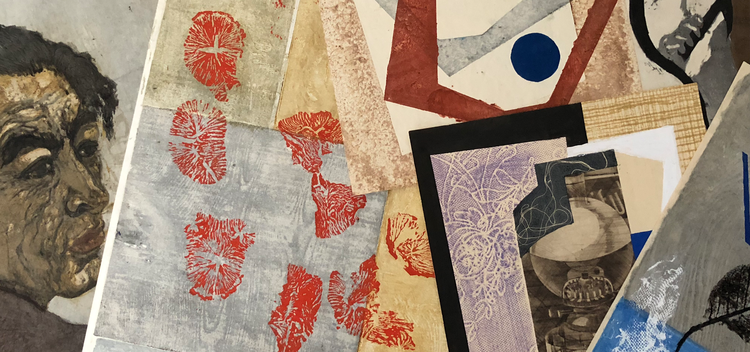GLOSSARY OF RELEVANT TERMS:
A HELPFUL ARRAY OF COMMONLY USED TERMS JAPANESE PRINT COLLECTORS COME ACROSS
Collecting Japanese prints can be daunting. There are countless artists to choose from, a variety of periods and styles, not to mention different editions. To make matters worse there are countless Japanese terms. At CJP we make it easier for you! Here's a comprehensive list of Japanese terms you are sure to come across. Let’s look at the common dangers that lead to damage and the relatively easy solutions to prevent such problems from occurring in the first place.
Aiban Print size, approximately 32 x 22 cm
Akae Porcelain with overglaze polychrome enamel with red
Akikusa Herbs and flowers from fall
Amida Buddha The Buddha who presides over the Pure Land
Aoi – No – Mon Family’s crest of Tokugawa clan (Tokugawa Period 1603 – 1868)
Asakusa Section of Tokyo known for its amusements and entertainment; formerly included the notorious Yoshiwara and the home of Hokusai
Ashi Reed
Baren Disk made bamboo and bamboo leaf used for applying pressure on the reverse of prints when printing with woodblocks
Basho One of Japan's most important haiku poets
Benkei Large and powerful mountain priest who became the faithful retainer of the medieval hero Yoshitsune
Benten Goddess of music, the only woman among the seven happy gods
Bento Lunchbox
Bijin Beautiful woman
Bijin-e, Bijin-ga Pictures of beautiful women
Bijutsu Art, fine arts, or visual art
Bokashi Printing technique used to create a gradation of color intensity
Bizen Unglazed stoneware produced near Okayama
Bugaku Ancient form of music and dance performed with masks
Bunraku Puppet theater
Byobu Folding screen
Cha no yu Tea ceremony or way of tea. Also associated with connoisseurship of poetry and the fine and applied arts
Chagama Iron kettle for tea
Cha-ire Pottery or porcelain tea jar or tea caddy
Chuban Print size, approximately 25 x 17 cm
Daikoku One of the seven happy gods, representing the wealth of the land.
Daimyo Lords in feudal Japan
Ebisu One of the Seven Happy Gods, usually portrayed with a sea bream
Edo The name of the period from 1603 to 1867 when Japan was ruled by the Tokugawa family; also known as the Tokugawa Period
Ehon "Picture book'; book illustrated with woodblock prints
Emma-o King of hell
Fudo Myo-o Buddhist deity and chief of the Five Great Kings of Light
Fukei Scenery
Fukusei Reproduction
Fukusei Hanga Woodblock print reproduction of a painting or an original print
Fukurokuju God of wisdom and one of the Seven Happy Gods.
Futaoki Lid rest of tea ceremony utensil
Ga A suffix meaning "picture by"--often used as the last character to a signature
Gagaku Ceremonial music and dance usually reserved for the aristocracy
Gama Sennin Taoist forest or mountain dweller who remains youthful to an inordinate age and who is associated with toads
Gashu Collection of pictures
Geisha Female entertainers who are highly trained in classical Japanese music and dancing as well as literature and conversational arts
Gendai Present day or contemporary
Tale of Genji Celebrated eleventh-century novel by Murasaki Shikibu
Go Artist's pen-name
Gofun An opaque white pigment often splashed on a print to imitate effects such as snow in a three-dimensional manner
Hagi Bush clover, one of the seven Grasses of Autumn
Hagoita A battledore for New year’s game
Hake-e Painted by brush
Haiku A formalized seventeen-syllable poem. It is terse, subtle, associated with a season, and swift in its imagery
Hakuji White porcelain
Hana Flower(s)
Hanga A woodcut, a woodblock print
Hanko A stamped or impressed seal
Hanmoto A publisher of woodblock prints
Hanshita-e The finished drawing of a print that is pasted on the block of wood that will be carved into the key block
Haori A jacket worn over a kimono
Harimaze Techniques of affixing objects like fans to screens
Hasira-e "Pillar print'
Heisei Period of time in Japan from 1989 to present
Hibatchi A Japanese heating appliance using charcoal as fuel
Hinoki Cypress
Hiragana Cursive Japanese script
Hotei One of the seven lucky gods--god of contentment
Ikebana The Japanese art of flower arrangement
Ino A wild boar
Jizuri Self-printed
Jurojin One of the seven happy gods--god of wisdom
Kabuki A classical Japanese dance drama whose performers are known for elaborate make-up
Kacho Flowers and Birds
Kacho-e Pictures of flowers and birds
Kagura Sacred ceremonial dances usually performed at Shinto shrines
Kakemono Hanging scroll
Kakihan Written or carved seal of monogram as distinguished from a stamped or impressed seal
Kanji Chinese characters adopted by the Japanese in their written language.
Kannon A Buddha who is revered as the goddess of mercy in Japan and connected with the Lotus Sutra
Kano school School of screen painting that began in the Muromachi period through the Edo period
Kansai An area in Japan which includes Kobe, Osaka, Nara and Kyoto
Kanto An area in Japan which includes Tokyo and Yokohama
Karamatsu Chinese pine
Katami Gawari A momoyama design motif resembling a lightning bolt
Kensui Tea ceremony utensil
Keyaki Zeilova wood
Key Block The black outline of a design and is typically the first block that's printed on a print
Kiku gata The shape or of chrysanthemum
Kikyo Bluebell or balloon flower, one of the seven types of grasses of Autumn
Kimono Traditional Japanese clothes
Kimpun Gold power
Kiseru Smoking Pipe
Koban Print size being used for one-half of an aiban (22 x 16 cm) or chuban (17 x 12 cm) or one-fourth of an oban (18 x 13 cm)
Kogo Incense container
Koma A top
Kozo Traditional Japanese paper made of mulberry fiber used in woodblock prints
Kougai Ornamental hairpins with Makie work
Kuchi-e Woodblock-printed illustrations for novels and literary magazines
Kuro Black
Kushi Comb, usually decorated by Makie
Kusunoki Masashige Medieval warrior
Kyogen Comic interludes between Noh dramas
Maiko An apprentice geisha
Manga Comic pictures or caricatures, sketchbooks
Meiji Period in Japan from 1868A.D to 1912A.D.
Mingei Folk art
Mizusashi Water jug, a pitcher, a carafe which is part of the tea ceremony
Mokume Design technique simulating the natural grain of wood
Mon Identifying crest, emblem, or family insignia often found on the clothes of actors or historical figures
Moku Hanga Woodblock print
Nanga Chinese style painting
Natsume Lacquer tea caddy
Nagamotchi A large oblong chest (for clothing, personal effects, etc)
Netsuke Toggle attached to inro, tonkotsu, tabacoo pouch, etc. by a cord and hung at the waist
Noh (Play) Formalized dance – drama in which the main character (shite) wears a mask
Noren Short divided curtain hung at the entrance of a shop and bearing its name or crest
Oban Print size approximately 37 x 26 cm
Obi The sash for securing the kimono about the body
Ohgi – Gata The shape of Ohg (a folding fan)
Okubi-e 'Picture of a large head'--A close-up portrait
Oni Demon, devil, fiend
Onnagata "Female Form"--Male actors in Kabuki theater who played female roles
Onsen Japanese hot springs
Otanzaku Print size--approximately 37 x 17 cm. Derived from the shape of the poem slip or tanzaku.
Reishi A type of mushroom for longevity
Rimpa (Style) of painting begun during the Momoyama period that used precious materials like gold and silver on screens, fans, etc
Sagi White Egret or Heron
Sashi-e An illustration
Saigyo A traveling priest often represented with staff and pilgrim hat and viewing mount Fuji
Saku Suffix meaning "work of", often used as the last character of a signature
Sakazuki Sake cup
Samisen Three-stringed instrument with a small square body, rounded sides, and a long neck
Sansui -Zu Landscape, scenery
Satsuma Type of pottery and porcelain produced in Kyushu
Saya Sheath
Sennin Taoist Forest and mountain hermits who live inordinately long lives
Seto Turihana Ire Hanging flower vase in the style of Seto Kiln
Setsubun Bean Throwing celebration (after lunar new year) to expel demons and welcome good fortune
Sha Suffix meaning 'depiction' or 'depicted by'. Sometimes used as the last character of a signature.
Shakuhachi Wind instrument made of bamboo
Shichi fuku Jin Seven happy gods, Daikokutenn, Yebisu, Bishamonten, Benzaiten, Fukurokuju, Zyurojin, Hotei
Shikishi Square piece of fancy paper for writing a poem on
Shikishiban Print size--square format approximately 23 x 23 cm
Shikishi bako Fitted box containing poetry writing
Shikishi Kake A hanger for Shikishi
Shikunshi The four gentlemanly plants – plum blossom, bamboo, chrysanthemum, and orchid
Shin Hanga "New prints'-- 20th century prints utilizing traditional paradigm--collaboration between publisher, artist, woodblock carvers and printers
Shiro White
Shinto The indigenous religion of Japan whose focus of worship is nature and ancestors
Shishi A kind of lion often appearing in pairs as guardians of Shinto shrines
Sho Chiku Bai Pine, bamboo and plum blossoms in combination--a symbol for auspicious occasions in Japan
Shokudai Candle stand
Showa Period of time in Japan from 1926/12-25 to 1989/1/7
Sosaku Hanga "Creative Prints" Prints that are entirely self-directed--artist conceives of the design, carves the blocks and prints the final work
Sumi Black ink (India ink) used in calligraphy and painting.
Sumi-e Black-ink painting
Suri Rubbed, chafed, filed, pounded
Susuki Pampas grass
Suzuri (bako) Inkstone box. A fitted box containing writing implements such as an inkstand, water dropper and brushes
Taisho Period of time in Japan from 1912/7/30 to 1926/12/25
Takarabune A treasure ship
Take-e Bamboo motif
Tamagushi Ornamental hair pins with gem stones
Tansu Chest of drawers with decorative hardware
Tanuki A badger
Tate-e Vertically aligned print
Tatejima A vertical stripe
Tayu The highest ranked courtesan
Teshoku Handheld candle stand
Tokaido Major road used in the Edo period between Kyoto and Edo (modern-day Tokyo)
Tokkuri A sake bottle
Tokonoma Decorative alcove of a Japanese room, where a seasonal scroll and flower arrangement are traditionally placed
Tomobako Original wooden box in which an object is stored after completion by the artist
Torii A high gate, often red with two curved crossbars, at the entrance to a sacred Shinto area
Tsutsubana ire Cylinder shaped flower vase
Turu kubi The shape of crane neck used for flower vases
Ueno A section of Tokyo which includes Shinobazu Pond, Ueno Park, and several museums
Ukiyo-e Pictures of the floating world"--prints and paintings showing the fleeting pleasures of urban Edo between 1600-1868
Uzumaki Spiral
Washi Handmade paper
Yoga Western-style painting
Yakan Tea pot
Yoko-e A horizontally aligned print
Yoshiwara A brothel district in Tokyo.
Yujo A courtesan
Yukata Light summer kimono made of cotton, usually in a blue and white pattern. This type of kimono is typically worn at hot springs or onsen
Yunomi Teacup for daily use
Zabuton A floor cushion
Zen Form of Buddhism traditionally said to have been brought to Japan from China by Bodhidharma (Daruma)



